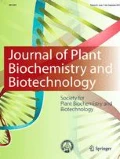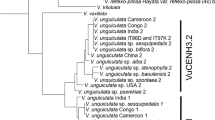Abstract
Centromere is the defining unit of a chromosome where kinetochore complex assembles and facilitates chromosome segregation. Centromeres contain unique repetitive sequences and are enriched with transposons and retrotransposons. Although how centromere is determined is still not clearly understood, binding of a key protein, namely, the Centromeric Histone H3 (CENH3) to centromeric repetitive DNA sequences has been found to be critical for the specification of centromere. Hence, centromeres are said to be epigenetically specified by CENH3. Despite considerable variation in size and sequence, CENH3 protein shows significant conservation of structure and function. CENH3 disruption or overexpression shows severe defects in spindle fiber attachment and ultimately leads to embryo lethality. Basic studies on complementation of CENH3 in Arabidopsis thaliana have led to the development of a novel method of haploid production through selective elimination of one set of parental chromosomes in the zygote. These findings have also shed new light on selective loss of chromosomes in interspecific crosses of Hordeum vulgare × H. bulbosum. Here, we briefly review unique features of CENH3 and discuss the new plant breeding opportunities that have emerged from the study of CENH3.


Similar content being viewed by others
Abbreviations
- CATD:
-
CENP-A targeting domain
- CID:
-
Centromere identifier
- CPAR-1:
-
Centromeric protein A related 1
- CSE4:
-
Chromosome segregation 4
- HCP3:
-
Holocentric protein 3
- HFD:
-
Histone fold domain
- HTR12:
-
Histone three related 12
References
Bailey AO, Panchenko T, Sathyan KM, Petkowski JJ, Pai PJ, Bai DL, Russell DH, Macara IG, Shabanowitz J, Hunt DF, Black BE, Foltz DR (2013) Post translational modification of CENP-A influences the conformation of centromeric chromatin. Proc Natl Acad Sci USA 110:11827–11832
Birchler JA, Gao Z, Sharma A, Presting GG, Han F (2011) Epigenetic aspects of centromere function in plants. Curr Opin Plant Biol 14:217–222
Black BE, Foltz DR, Chakravarthy S, Luger K, Virgil L, Cleveland DW (2004) Structural determinants for generating centromeric chromatin. Nature 430:578–582
Buchwitz BJ, Ahmad K, Moore LL, Roth MB, Henikoff S (1999) A histone-H3-like protein in C. elegans. Nature 401:547–548
D’Erfurth I, Jolivet S, Froger N, Catrice O, Novatchkova M, Mercier R (2009) Turning meiosis into mitosis. PLoS Biol 7:e1000124M. doi:10.1371/journal.pbio.1000124
Dirks R, van Dun K, de Snoo CB, van den Berg M, Lelivelt CL, Voermans W, Woudenberg L, de Wit JP, Reinink K, Schut JW, van der Zeeuw E, Vogelaar A, Freymark G, Gutteling EW, Keppel MN, van Drongelen P, Kieny M, Ellul P, Touraev A, Ma H, de Jong H, Wijnker E (2009) Reverse breeding: a novel breeding approach based on engineered meiosis. Plant Biotechnol J 7:837–845
Dunemann F, Schrader O, Budahn H, Houben A (2014) Characterization of centromeric histone H3 (CENH3) variants in cultivated and wild carrots (Daucus sp.). PLoS ONE 9:e98504
Earnshaw WC, Rothfield N (1985) Identification of a family of human centromere protein using autoimmune sera from patients with sclerodoma. Chromosoma 91:313–321
Ekwall K (2007) Epigenetic control of centromere behavior. Annu Rev Genet 41:63–81
Hall SE, Kettler G, Preuss D (2003) Centromere satellites from Arabidopsis populations: maintenance of conserved and variable domains. Genome Res 13:195–205
Hall AE, Keith KC, Hall SE, Copenhaver GP, Preuss D (2004) The rapidly evolving field of plant centromeres. Curr Opin Plant Biol 7:108–114
Heckmann S, Lermontova I, Berckmans B, Veylder LD, Baumlein H, Schubert I (2011) The E2F transcription factor family regulates CENH3 expression in Arabidopsis thaliana. Plant J 68:646–656
Henikoff S, Ahmad K, Platero JS, Van Steensel B (2000) Heterochromatic deposition of centromeric histone H3-like proteins. Proc Natl Acad Sci USA 97:716–721
Heun P, Erhardt S, Blower MD, Weiss S, Skora AD, Karpen GH (2006) Mislocalization of the Drosophila centromere-specific histone CID promotes formation of functional ectopic kinetochores. Dev Cell 10:303–315
Howman EV, Fowler KJ, Newson AJ, Redward S, MacDonald AC, Kalitsis P, Choo KH (2000) Early disruption of centromeric chromatin organization organization in centromeric protein A (Cenpa) null mice. Proc Natl Acad Sci USA 97:1148–1153
Hui L, Lu L, Heng Y, Qin R, Xing Y, Jin W (2010) Expression of CENH3 alleles in synthesized allopolyploid Oryza species. J Genet Genomics 37(10):703–711
Jin W, Melo JR, Nagaki K, Talbert PB, Henikoff S, Dawe RK, Jiang J (2004) Maize centromeres: organization and functional adaptation in the genetic background of oat. Plant Cell 16:571–581
Karimi-Ashtiyani R, Ishii T, Niessen M, Stein N, Heckmann S, Gurushidze M, Banaei-Moghaddam AM, Fuchs J, Schubert V, Koch K, Weiss O, Demidov D, Schmidt K, Kumlehn J, Houben A (2015) Point mutation impairs centromeric CENH3 loading and induces haploid plants. Proc Natl Acad Sci USA. doi:10.1073/pnas.1504333112
Kasha KJ, Kao KN (1970) High frequency haploid production in barley (Hordeum vulgare L.). Nature 225:874–876
Kawabe A, Nasuda S, Charlesworth D (2006) Duplication of centromeric histone H3 (HTR12) gene in Arabidopsis halleri and A. lyrata, plant species with multiple centromeric satellite sequences. Genetics 174:2021–2032
Kelliher T, Starr D, Wang W, McCuiston J, Zhong H, Nuccio ML, Martin B (2016) Maternal haploids are preferentially induced by CENH3-tailswap transgenic complementation in maize. Front Plant Sci 7:414. doi:10.3389/fpls.2016.00414
Kuppu S, Tan EH, Nguyen H, Rodgers A, Comai L, Chan SWL (2015) Point mutations in centromeric histone induce post-zygotic incompatibility and uniparental inheritance. PLoS Genet 11(9):e1005494. doi:10.1371/journal.pgen.1005494
Laurie DA, Bennett MD (1988) The production of haploid wheat plants from wheat × maize crosses. Theor Appl Genet 76:393–397
Lermontova I, Schubert V, Fuchs J, Klatte S, Macas J, Schubert I (2006) Loading of Arabidopsis centromeric histone CENH3 occurs mainly during G2 and requires the presence the presence of the histone fold domain. Plant Cell 18:2443–2451
Lermontova I, Fuchs J, Schubert V, Schubert I (2007) Loading time of the centromeric histone H3 variant differs between plants and animals. Chromosoma 116:507–510
Lermontova I, Koroleva O, Rutten T, Fuchs J, Schubert V, Moraes I, Koszegi D, Schubert I (2011) Knockdown of CENH3 in Arabidopsis reduces mitotic divisions and causes sterility by disturbed meiotic chromosome segregation. Plant J 68:40–50
Li ZY, Ge XH (2007) Unique chromosome behavior and genetic control in Brassica × Orychophragmus wide hybrids: a review. Plant Cell Rep 26:701–710
Lim KB, Yang TJ, Hwang YJ, Kim JS, Park JY, Kwon SJ, Kim J, Choi BS, Lim MH, Jin M, Kim HI, de Jong H, Bancroft I, Lim YP, Park BS (2007) Characterization of the centromere and peri-centromere retrotransposons in Brassica rapa and their distribution in related Brassica species. Plant J 49:173–183
Maehara K, Takahashi K, Saitoh S (2010) CENP-A reduction induces a p53-dependent cellular senescence response to protect cells from executing defective mitoses. Mol Cell Biol 30:2090–2104
Maheshwari S, Tan EH, West A, Franklin FCH, Comai L, Chan SWL (2015) Naturally occurring differences in CENH3 affect chromosome segregation in zygotic mitosis of hybrids. PLoS Genet 11(1):e1004970
Marimuthu MP, Jolivet S, Ravi M, Pereira L, Davda JN, Cromer L, Wang L, Nogue F, Chan SW, Siddiqi I, Mercier R (2011) Synthetic clonal reproduction through seeds. Science 331:876
Maruyama S, Kuroiwa H, Miyagishima SY, Tanaka K, Kuroiwa T (2007) Centromere dynamics in the primitive red alga Cyanidioschyzon merolae. Plant J 49:1122–1129
Masonbrink RE, Gallagher JP, Jareczek JJ, Renny-byfield S, Grover CE, Gong L, Wendel JF (2014) CenH3 evolution in diploids and polyploids of three angiosperm genera. BMC Plant Biol 14:383–393
Melters DP, Bradnam KR, Young HA, Telis N, May MR, Ruby JG, Sebra R, Peluso P, Eid J, Rank D, Garcia JF, Derisi JL, Smith T, Tobias C, Ross-Ibarra J, Korf I, Chan SW (2013) Comparative analysis of tandem repeats from hundreds of species reveals unique insights into centromere evolution. Genome Biol 14:R10
Mendiburo MJ, Padeken J, Fulop S, Schepers A, Heun P (2011) Drosophila CENH3 is sufficient for centromere formation. Science 334:686–690
Monen J, Maddox PS, Hyndman F, Oegema K, Desai A (2005) Differential role of CENP-A in the segregation of holocentric C. elegans chromosomes during meiosis and mitosis. Nat Cell Biol 7:1248–1255
Nagaki K, Murata M (2005) Characterization of CENH3 and centromere-associated DNA sequences in sugarcane. Chromosome Res 13:195–203
Nagaki K, Cheng Z, Ouyang S, Talbert PB, Kim M, Jones KM, Henikoff S, Buell CR, Jiang J (2004) Sequencing of a rice centromere uncovers active genes. Nat Genet 36:138–145
Nagaki K, Kashihara K, Murata M (2005) Visualization of diffuse centromeres with centromere-specific histone H3 in the holocentric plant Luzula nivea. Plant Cell 17:886–1893
Nagaki K, Kashihara K, Murata M (2009) A centromere DNA sequence colocalized with a centromere-specific histone H3 in tobacco. Chromosoma 118:249–257
Nagaki K, Yamamoto M, Yamaji N, Mukai Y, Murata M (2012) Chromosome dynamics visualized with an anti-centromeric histone H3 antibody in Allium. PLoS ONE 7:e51315
Neumann P, Navratilova A, Schroeder-Reiter E, Kobližkova A, Steinbauerova V, Chocholova E, Novak P, Wanner G, Macas J (2012) Stretching the rules: monocentric chromosomes with multiple centromere domains. PLoS Genet 8:e1002777
Neumann P, Pavlíková Z, Koblížková A, Fuková I, Jedličková V, Novák P, Macas J (2015) Centromeres off the hook: massive changes in centromere size and structure following duplication of CenH3 gene in Fabeae species. Mol Biol Evol. doi:10.1093/molbev/msv070
Palmer DK, O’Day K, Wemer MH, Andrews BS, Margolis RL (1987) A 17- KD centromere protein (CENP-A) co-purifies with nucleosome core particles and with histones. J Cell Biol 104:805–815
Ravi M, Chan SWL (2010) Haploid plants produced by centromere-mediated genome elimination. Nature 464:615–619
Samel A, Cuomo A, Bonaldi T, Ehrenhofer-Murray AE (2012) Methylation of CenH3 arginine 37 regulates kinetochore integrity and chromosome segregation. Proc Natl Acad Sci USA 109:9029–9034
Sanei M, Pickering R, Kumke K, Nasuda S, Houben A (2011) Loss of centromeric histone H3 (CENH3) from centromeres precedes uniparental chromosome elimination in interspecific barley hybrids. Proc Natl Acad Sci USA 108:498–505
Schuh M, Lehner CF, Heidmann S (2007) Incorporation of Drosophila CID/CENP-A and CENP-C into centromeres during early embryonic anaphase. Curr Biol 17:237–243
Shelby RD, Monier K, Sullivan KF (2000) Chromatin assembly at kinetochores is uncoupled from DNA replication. J Cell Biol 151:1113–1118
Stoler S, Keith KC, Curnick KE, Fitzgerald-Hayes M (1995) A mutation in CSE4, an essential gene encoding a novel chromatin-associated protein in yeast, causes chromosome nondisjunction and cell cycle arrest at mitosis. Genes Dev 9:573–586
Takahashi K, Chen ES, Yanagida M (2000) Requirement of Mis6 centromere connector for localizing a CENP-A-like protein in fission yeast. Science 288:2215–2219
Takahashi K, Takayama Y, Masuda F, Kobayashi Y, Saitoh S (2005) Two distinct pathways responsible for the loading of CENP-A to centromeres in the fission yeast cell cycle. Philos Trans R Soc Lond B Biol Sci 360:595–607
Talbert PB, Masuelli R, Tyagi AP, Comai L, Henikoff S (2002) Centromeric localization and adaptive evolution of an Arabidopsis histone H3 variant. Plant Cell 14:1053–1066
Tek AL, Kashihara K, Murata M, Nagaki K (2014) Identification of the centromere-specific histone H3 variant in Lotus japonicus. Gene 538:8–11
Wang G, He Q, Liu F, Cheng Z, Talbert PB, Jin W (2011) Characterization of CENH3 proteins and centromere associated DNA sequences in diploid and allotetraploid Brassica species. Chromosoma 120:353–365
Wijnker E, van Dun K, de Snoo CB, Lelivelt CL, Keurentjes JJ, Naharudin NS, Ravi M, Chan SW, de Jong H, Dirks R (2012) Reverse breeding in Arabidopsis generates homozygous parental lines from a heterozygous plant. Nat Genet 44(4):467–470
Zhong CX, Marshall JB, Topp C, Mroczek R, Kato A, Nagaki K, Birchler JA, Jiang J, Dawe RK (2002) Centromeric retroelements and satellites interact with maize kinetochore protein CENH3. Plant Cell 14:2825–2836
Author information
Authors and Affiliations
Corresponding author
Ethics declarations
Conflict of interest
AW and VK received Research Fellowship from ICAR/IARI, New Delhi, India. SRB has received grant from the Department of Biotechnology, Govt. of India for pursuing work on CENH3.
Rights and permissions
About this article
Cite this article
Watts, A., Kumar, V. & Bhat, S.R. Centromeric histone H3 protein: from basic study to plant breeding applications. J. Plant Biochem. Biotechnol. 25, 339–348 (2016). https://doi.org/10.1007/s13562-016-0368-4
Received:
Accepted:
Published:
Issue Date:
DOI: https://doi.org/10.1007/s13562-016-0368-4




